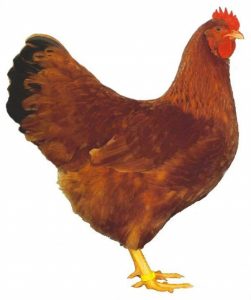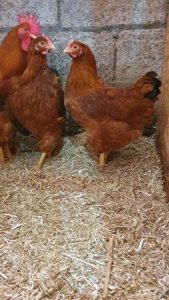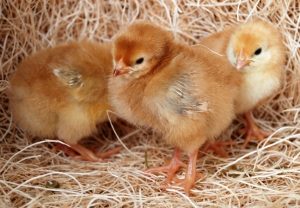The New Hampshire Red Chicken was originally bred at The New Hampshire Agriculture Experiment Station just before World War 2 in 1914 and admitted to the American Breed Standard in 1935. Local farmers in New Hampshire were active in the breeding programme, which heavily involved the reliable Rhode Island Red Chicken, as the aim was to produce a medium sized dual-purpose bird, that quickly became plump and laid plentiful numbers of eggs.
The Rhode Island Reds were used in this breeding program as they grew quickly and had good feather coverage, essential in a state that can suffer cold winters and where farmers will want to keep New Hampshire Reds outside for as many months as possible. In extreme cold New Hampshire reds will need to be confined indoors, as their combs and wattles can freeze.
The successful breeding program produced New Hampshire Red Chickens that are much lighter in color than Rhode Island Reds and have several practical advantages for chicken farmers: rapid growth, fast feathering, early maturity, large quantities of medium large brown eggs and vigor.
Mature hens will typically weigh around 6.5 pounds (3kg) and can be up to 15 inches (38 cms) tall. Male roosters can weigh up to 8.5 pounds (3.9 kg) and be over 17 inches (43 cms) tall.
A bantam cock will typically weigh just under 34 ounces (.95kg) and a bantam hen will weigh just under 30 ounces (.85 kg).
New Hampshire Reds are available in the USA, UK and Europe and are suitable for dual egg and meat production. They are often kept by backyard chicken enthusiasts for their good looks, easy going temperament, long-season egg laying ability and general robustness.
New Hampshire Reds adapt well to confinement, are mostly good natured but can be competitive.
Eggs
Size
Eggs can be medium to large in size.
Color
Eggs range in color from brown, speckled to dark brown
Production per year
200 to 260 eggs per year
When do they start laying eggs?
From 5 months
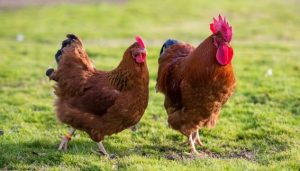
New Hampshire Red Characteristics
Temperament / Are they good as pets?
These are a medium-sized birds who are quite energetic and relatively docile, but being competitive they can easily become aggressive and squabble. This is particularly noticeable if a cockerel doesn’t have enough hens to ‘service’. To overcome this, ensure your flock of New Hampshire Reds does not have too many cockerels, or they will fight.
How do I tame New Hampshire Red chickens?
The best way to tame a chicken is to handle it when it is still young; this gets your chickens used to people. If you have older chickens that need taming, try feeding them out of your hand regularly.
How many do I need to buy?
2 chickens is the absolute minimum you need for a flock, we recommend around 8 as a small flock number. An ideal ratio is one cockerel to 8 or 10 hens.
How much space do they need?
As these are medium sized birds, ideally 4 square feet per mature bird in a coop. In a run around 20 square feet minimum per bird. New Hampshire Reds love to be outside foraging for food. Luckily New Hampshire reds don’t fly much, unless in danger, so high -level containment fencing above 6 feet (182 cms) is not necessary. Some backyard flocks are kept in large sheds, rather like turkey flocks.
Will they mix with my other chickens?
In general New Hampshire Reds get along well with other breeds of chickens, but as these are energetic birds they may dominate and ‘bully’ quieter breeds. New Hampshire Reds and Bantams will get along fine, as long as they are not too closely confined and there is adequate room for the Bantams to get out from under foot of the larger birds.
Appearance
New Hampshire Red Chickens are usually light red or reddish/brown, sometimes described as ‘fox red’ and kept as general-purpose fowl for succulent meat and consistent egg production, typically producing around 4 to 5 eggs per week.
The color of the skin is yellow giving a ‘corn fed’ appearance as a table roasting bird. This is a well feathered bird, with no visible skin on view. Chestnut red or dark red/brown feathers on the chest and neck are quite common and tail feathers are often black.
Female birds sometimes have small black tipped feathers on their necks. The beak is usually yellow or reddish horn colored, with a yellow tip. Comb, wattles and earlobes are all bright red and eyes are dark brown. Shanks and toes and the bottom of the feet are usually yellow.
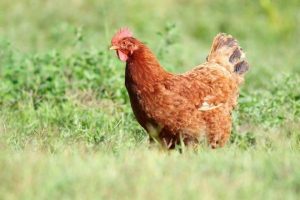
Feeding
What should I feed them?
When you first get your chickens home you should feed them growers mash, as it has a higher percentage of protein (19%) and is refined so that it can be easily ingested.
You should feed them growers mash up until 6 weeks where they should be fed chicken pellets which is just feed in pellet form, this has between 15-16% protein.
At 18 weeks your chickens need more nutrients to help with egg production so slowly start feeding them layers mash or pellets which has around 16% protein.
Chickens will need access to fresh drinking water all day long, they will prefer cool drinking water, no one is quite sure why maybe it’s a prehistoric throwback. As New Hampshire Reds are medium sized birds it is important to have the feed and water at the proper height for all birds in the pen.
Ideally feed and water should be at back level. If the water is too low down, in order to accommodate bantams, New Hampshire Reds may scratch litter into it and the water will go bad quickly.
Your chickens also need grit to help with egg production, so make sure there is always some within easy access to them at all times.
New Hampshire Reds like a perch height of between 2 and 4 feet off the ground to feel safe and secure. It is important that chickens have enough ‘uncrowded’ space to perch comfortably, as an unhappy and stressed chicken won’t lay many eggs and will be more prone to squabbling with other members of the flock.
How much should I feed them?
New Hampshire Red Chickens are active and hungry birds, but you cannot force feed them to accelerate growth when young; you have to patiently build the frame first and then put weight on using top quality feed.
They will eat anywhere between 2.5 oz (70g) and 4 oz (113g) a day, but on average breeders feed their chickens 3.5 oz (99g) a day. Start by feeding them this and then adjust the weight of feed around how much they consume. You can leave the feed in a feeder for them to eat whenever they please or you can give them set meal times.
New Hampshire Red Chickens love to forage outside for grubs and bugs.
Your chickens also need grit to help with egg production, so make sure there is always some easily acccesable to them at all times.
What can’t they eat?
Chocolate and beans are the two main foods that shouldn’t be eaten by chickens. The phytohemagglutinin in beans can lead to fatalities and the theobromine in chocolate can cause heart problems. Moldy food that has bad bacteria in it should not be fed to chickens as it can make them very unwell. For this reason, it is illegal to feed your chickens leftovers in the UK.
What do I need to keep chickens?
The most essential item you need to keep chickens is a coop, which should ideally be .4 m2 or 4 square feet per chicken.
Their run needs 8-20 square feet per chicken. In the coop they should have a perch to sleep on and a wooden laying box for their eggs.
You should invest in a sunken fence to go over and around the coop to keep them safe at night. Find a water bowl which they can’t stand in or push over and place it in the shade, so the water doesn’t get too warm. Feed and water for New Hampshire Red Chickens are best placed off the ground, at around the ‘back’ height of the bird. Raised feed and water bowl holders are easily obtained.


